Hooded Orioles (Icterus cucullatus) are medium-sized songbirds found in the southwestern United States and Mexico.
They are recognized by their vibrant black-and-yellow plumage and the hooded look of the males. You may have seen them dangling upside down from branches or building intricate basket-like nests from drooping tree branches. Have a closer look at the lives of those critters.
On this page
Identification
Hooded Orioles are medium-sized songbirds, measuring 7-8 inches long with a wingspan of 9-11 inches. They have a slim, elongated body with a relatively long tail and a sharp-tipped, slightly down-curved bill. Their tails are long and rounded, and their eyes are dark, almost black.
Male
Male Hooded Orioles’ plumage is a stunning combination of black and various shades of yellow and flame orange. Depending on the location, they may be orange instead of yellow, for example, in south Texas.
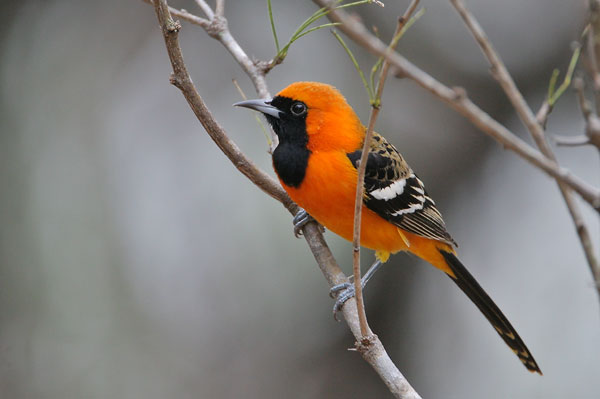
Generally speaking, they have yellow undersides and rumps and black tails, backs, faces, and throat patches. The most distinctive feature is their bright orange-yellow hood that extends from the head to the upper back, giving the birds their name. Their wings are black with white wingbars. They have delicate black legs and black bills.
Female
Female Hooded Orioles do not have such a contrasting appearance. Their plumage is greenish-yellow overall with slightly grayish backs and bellies. They have dark but pale wings with thin white wingbars. Instead of black legs and bills, they have grayish legs and pinkish bills.
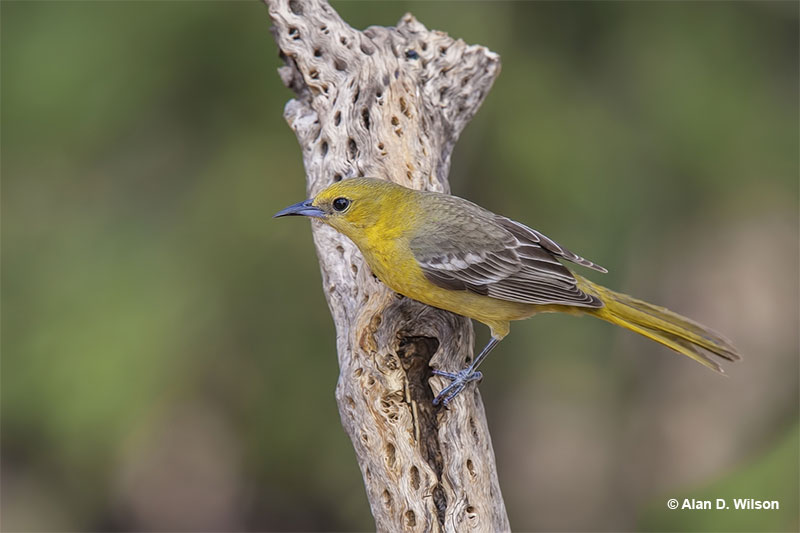
Juvenile Hooded Orioles look similar to females but are even duller, more brownish and may look a bit shaggy. As they get older, males develop black throat patches even though the general coloring may look more similar to females.
Vocalizations
The songs of Hooded Orioles are abrupt and short, lasting for 1-4 seconds, and lack the melodious whistling notes that other oriole species have.
Both males and females sing, but males have more complex songs.
Song patterns and specifics are highly variable and depend on the location and individual. Generally speaking, their songs are short and rapid, consisting of a series of warbles, whistles, and chatters.
Hooded Oriole calls are as varied as their songs. They may give sharp whistled weet notes or harsh chuck calls. If they are disturbed or threatened, they give a rapid and dry chatter call. Juveniles call with soft chut and harsher chet calls.
Food
Hooded Orioles are omnivorous and feed on insects, nectar, and fruit. Their feeding habits can vary depending on the season and food availability. Insects make up a significant portion of their diet.
They feed on various insects such as beetles, ants, caterpillars, wasps, spiders, and other small invertebrates. Orioles often catch insects by gleaning them from leaves, flowers, and branches.
They also feed on nectar from tubular flowers, such as aloes, hibiscus, agaves, and lilies by piercing the base of the flower with their pointed bills to reach it. This pointed bill also comes in handy when they choose to pierce fruits to drink its juice.
These agile fliers are known for hanging upside down to get to their food. You may see them do so to extract nectar from flowers, snatch a berry or some fruit, or when they’re looking for insects. They are very methodic foragers and move slowly along the branches.
Nesting and Eggs
Males arrive at the breeding grounds before females and establish and defend their territories by singing. When females enter their territories and land on a perch, the male will jump from branch to branch around her, fluttering his wings, bowing deeply from time to time, and singing soft melodies with his bill pointing upward. The female will respond in a similar manner.
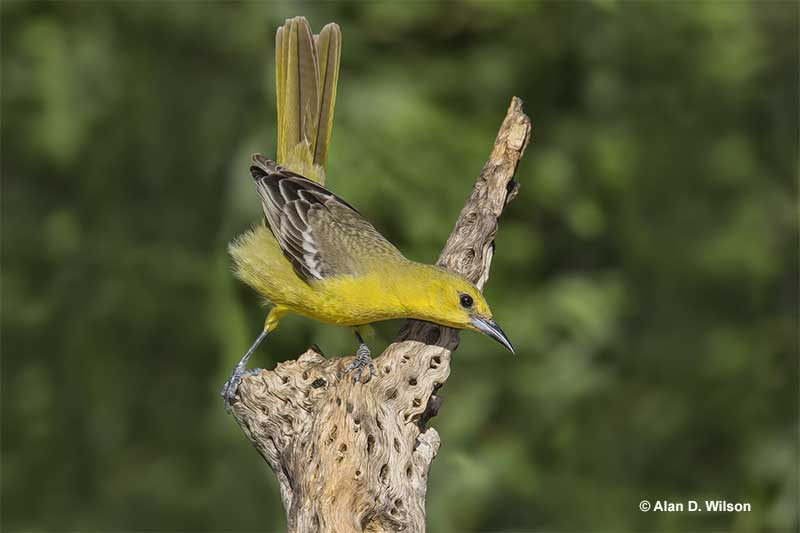
Hooded Oriole nests are usually 10-50 feet above the ground in a tall deciduous tree such as a fan palm, cottonwood, oak, eucalyptus, or sycamore.
The female builds the basket- or pouch-like nest from various plant fibers, such as grass or bark fibers, and lines it with plant hair, feathers, and plant down. Males help by bringing building materials.
This species may have up to two broods in a breeding season with 3-7, on average 4 eggs in a clutch. Hooded Oriole eggs are whitish, blotched with various darker colors from pale blue and lavender to brown and gray, and measure 0.8-1 inches long and 0.6-0.7 inches wide.
The female incubates the eggs on her own for 12-14 days but both parents take care of their offspring. Younglings leave the nest around two weeks after hatching.
Current Situation
Hooded Orioles range throughout the southwestern United States and Mexico. A part of the population is resident in Mexico and Baja California with the other part breeding in the United States and northern Mexico and migrating to southwestern Mexico for the winter.
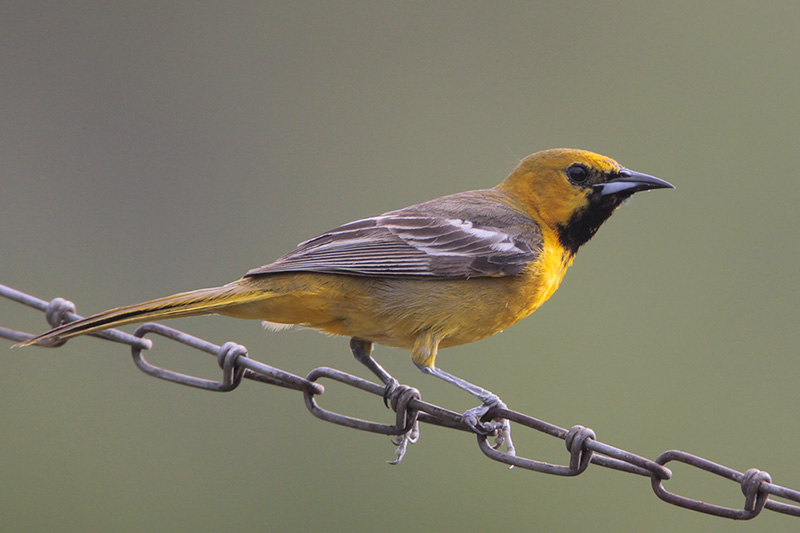
Hooded Orioles prefer rather open and dry habitats with scattered trees, including open woodlands, gardens, riparian areas, and orchards. Suitable nesting locations include trees with drooping branches, such as palms and eucalyptus trees, where they can suspend their distinctive hanging nests. They are also common in city parks and suburbs.
Hooded Orioles are listed as a species of least concern on the IUCN. Their population seems to be slightly increasing and they seem to be expanding their range further north thanks to people opting to plant ornamental palm trees.
Facts
- Hooded Orioles don’t have one specific song, it varies depending on the location and the individual. Even the same bird can sing different variations of it. They may also mimic and use the songs and calls of other birds, such as Ash-throated Flycatchers and Gila Woodpeckers.
- Hooded Orioles love to nest in palm trees. In certain areas, this has earned them the nickname “palm-leaf oriole”.
- Hooded Orioles have an average lifespan of 3-5 years. The oldest Hooded Oriole on record was at least 6 years old.
- If you want to attract Hooded Orioles to your yard, try putting out oranges, jelly, or hummingbird feeders with sugar water.
Similar Species
Hooded Orioles have quite a few similar species, especially at a cursory glance. However, they aren’t too hard to distinguish once you know what to look for. Here are three of the most similar species and the differences between them.
Bullock’s Oriole
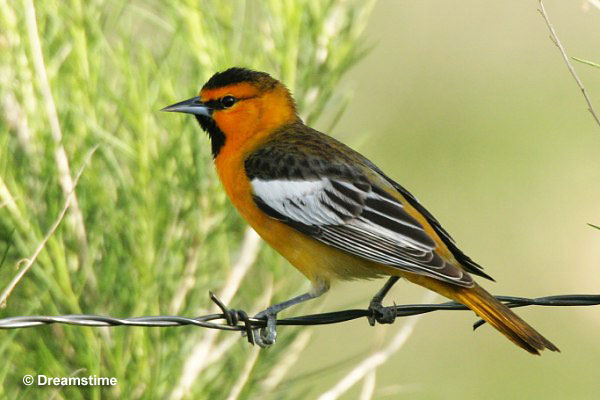
Bullock’s Orioles range throughout Mexico and the western United States, with their range bleeding slightly into western Canada. Males have an orange face with a black eyeline and cap, an orange underside and flanks, and a black back, tail, and wings with white wingbars. Females are duller. They have yellowish heads, chests, and tails, whitish bellies, gray backs, and dark wings with white wingbars.
Males can be distinguished by their heads. Hooded males have a yellow head with a black face mask, whereas Bullock’s males have a yellow head with a black eye stripe and cap. The latter also has more white on their wings. Female Hooded Orioles are uniformly yellow, whereas Bullock’s females have whitish bellies and gray backs.
Scott’s Oriole
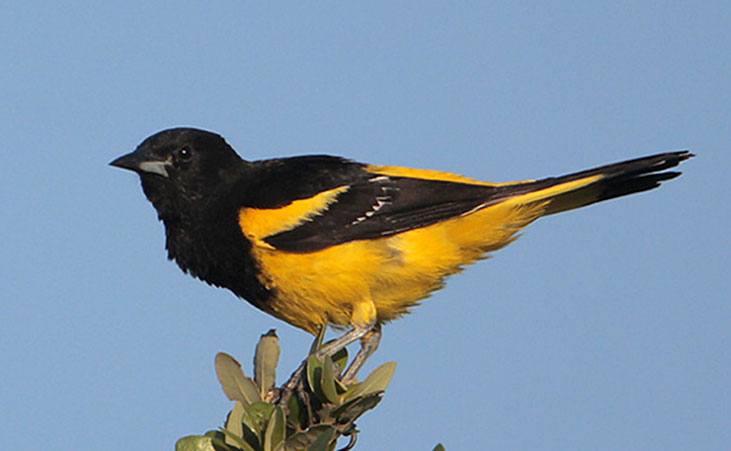
Scott’s Orioles have a similar range to Hooded Orioles in the United States. Males have yellow bodies and shoulders and black heads, backs, chests, and wings with white wingbars. Their tails are yellow and black. Females are olive-green above, dull yellow below, and have grimy-looking wings with white wingbars.
Males of the species can be best distinguished by their heads. Scott’s males have fully black heads whereas Hooded males have a yellowish-orange head with a black face and throat. Females are more similar but pay attention to their backs and heads. Hooded females are uniformly yellow overall with no markings, except for wings. Scott’s females, on the other hand, have grayish-green heads and gray-streaked backs.
Altamira Oriole
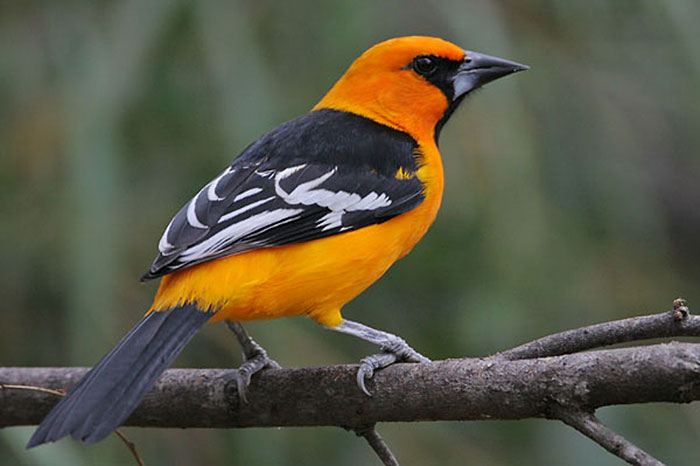
Altamira Orioles can be found in Mexico and the southernmost tip of Texas in the United States. Adults are bright orange with a black mask, throat, tail, and upper back. Their wings are black with white wingbars. Juveniles are paler and yellow with greenish backs, slight black eye stripes, and dark wings with white wingbars.
Frequently Asked Questions
How do you tell the difference between male and female Hooded Orioles?
Male Hooded Orioles have a contrasting black-and-deep yellow plumage whereas female Hooded Orioles are yellowish all over.
What is the difference between a Scott’s Oriole and a Hooded Oriole?
Male Scott’s Orioles have a fully black head whereas male Hooded Orioles have an orange head with a black face and throat. Female Hooded Orioles have a uniformly yellow plumage whereas female Scott’s Orioles have a yellowish-green plumage and grayish heads and backs.
Are Hooded Orioles blackbirds?
Hooded Orioles belong to the blackbird family.
Why are they called Hooded Orioles?
Hooded Orioles are named for the distinctive and vibrant orange-yellow hood or “hood-like” plumage that extends from the head to the upper back of the male.

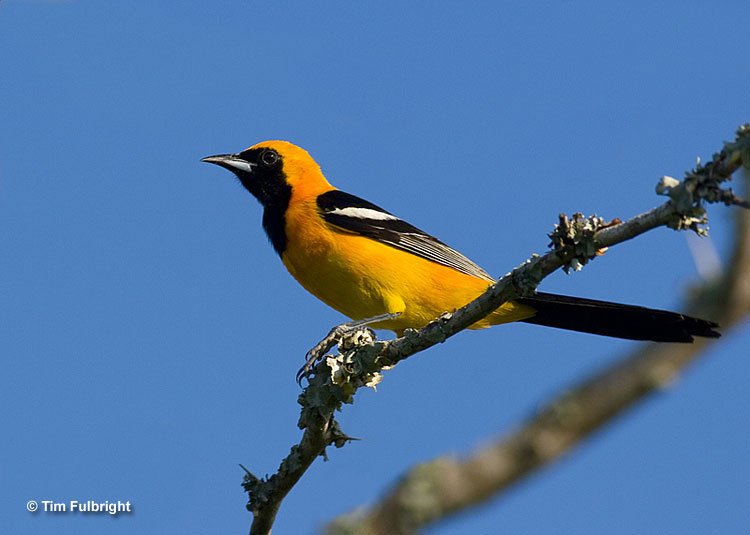
Cassie B
Sunday 11th of June 2023
Hello from Wisconsin! Avid bird and nature lover here! Trying to get more information about hooded orioles. While they are unlikely to be in Wisconsin, I believe I have captured pictures and videos of one in my yard. I do believe it could be a juvenile and have asked a few other people who are uncertain. I always attract Baltimore Orioles and Orchard Orioles, however, this bird was different with color markings. I do see on the rare occasion there have been some documented in Southeastern Wisconsin; this is where I’m from. Anyway I could show you a picture or video for clarification?
Patrick O'Donnell
Monday 19th of June 2023
@Cassie B, Your backyard sounds wonderful! As you mentioned, yes, a Hooded Oriole would be pretty rare in Wisconsin but you never know. Yes, we would love to see a photo or video to see what that bird is. Can you provide a link to them in the comments?